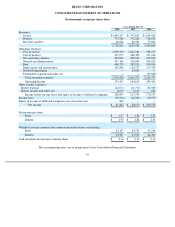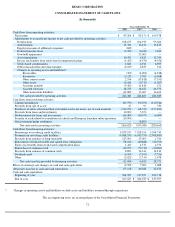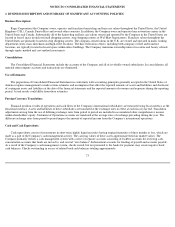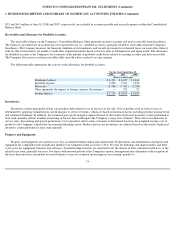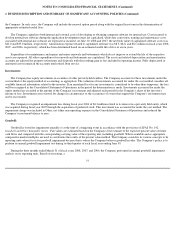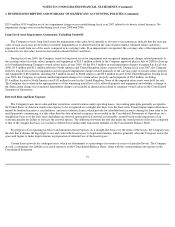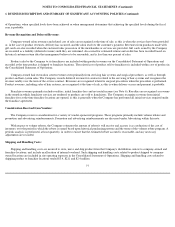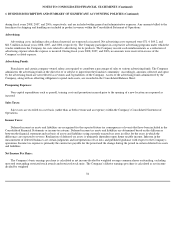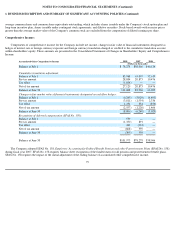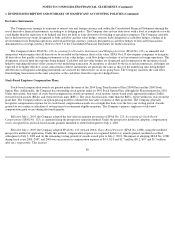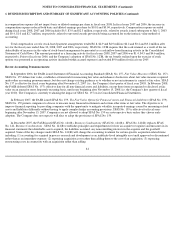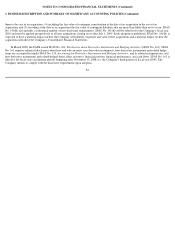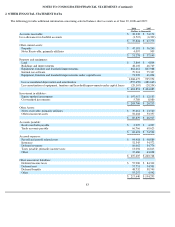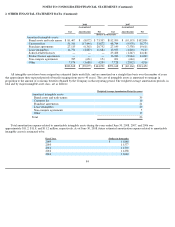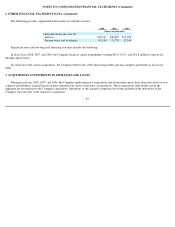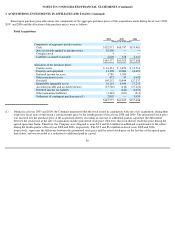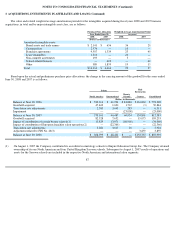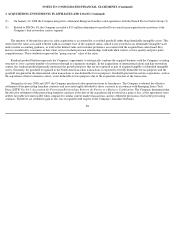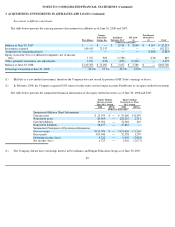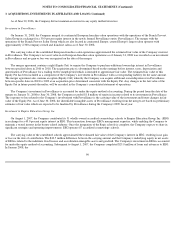Supercuts 2008 Annual Report Download - page 82
Download and view the complete annual report
Please find page 82 of the 2008 Supercuts annual report below. You can navigate through the pages in the report by either clicking on the pages listed below, or by using the keyword search tool below to find specific information within the annual report.
NOTES TO CONSOLIDATED FINANCIAL STATEMENTS (Continued)
1. BUSINESS DESCRIPTION AND SUMMARY OF SIGNIFICANT ACCOUNTING POLICIES (Continued)
Derivative Instruments:
The Company may manage its exposure to interest rate and foreign currency risk within the Consolidated Financial Statements through the
use of derivative financial instruments, according to its hedging policy. The Company does not use derivatives with a level of complexity or with
a risk higher than the exposures to be hedged and does not hold or issue derivatives for trading or speculative purposes. The Company currently
has or had interest rate swaps designated as both cash flow and fair value hedges, treasury locks designated as cash flow hedges, a hedge of its
net investment in its European operations and forward foreign currency contracts designated as cash flow hedges of forecasted transactions
denominated in a foreign currency. Refer to Note 5 to the Consolidated Financial Statements for further discussion.
The Company follows SFAS No. 133, Accounting for Derivative Instruments and Hedging Activities (SFAS No. 133), as amended and
interpreted, which requires that all derivatives be recorded on the balance sheet at fair value. SFAS No.133 also requires companies to designate
all derivatives that qualify as hedging instruments as fair value hedges, cash flow hedges or hedges of net investments in foreign operations. This
designation is based upon the exposure being hedged. Cash flow and fair value hedges are designated and documented at the inception of each
hedge by matching the terms of the contract to the underlying transaction. At inception, as dictated by the facts and circumstances, all hedges are
expected to be highly effective, as the critical terms of these instruments are generally the same as those of the underlying risks being hedged.
All derivatives designated as hedging instruments are assessed for effectiveness on an on-going basis. The Company classifies the cash flows
from hedging transactions in the same categories as the cash flows from the respective hedged items.
Stock-Based Employee Compensation Plans:
Stock-based compensation awards are granted under the terms of the 2004 Long Term Incentive Plan (2004 Plan) and the 2000 Stock
Option Plan. Additionally, the Company has outstanding stock options under its 1991 Stock Option Plan, although the Plan terminated in 2001.
Under these plans, four types of stock-based compensation awards are granted: stock options, equity-based stock appreciation rights (SARs),
restricted stock awards (RSAs) and restricted stock units (RSUs). The stock-based awards, other than the RSUs, expire within ten years from the
grant date. The Company utilizes an option-pricing model to estimate the fair value of options at their grant date. The Company generally
recognizes compensation expense for its stock-based compensation awards on a straight-line basis over the five-year vesting period. Awards
granted do not contain acceleration of vesting terms for retirement eligible recipients. The Company's primary employee stock-based
compensation grant occurs during the fourth quarter.
Effective July 1, 2003, the Company adopted the fair value recognition provisions of SFAS No. 123, Accounting for Stock-Based
Compensation (SFAS No. 123), as amended using the prospective transition method. Under the prospective method of adoption, compensation
cost is recognized on all stock-based awards granted, modified or settled subsequent to July 1, 2003.
Effective July 1, 2005, the Company adopted SFAS No. 123 (revised 2004), Share-Based Payment (SFAS No. 123R), using the modified
prospective method of application. Under this method, compensation expense is recognized both for (i) awards granted, modified or settled
subsequent to July 1, 2003 and (ii) the remaining vesting periods of awards issued prior to July 1, 2003. The impact of adopting SFAS No. 123R
during fiscal years 2008, 2007, and 2006 was an increase in compensation expense of $0.4, $1.0 and $2.7 million ($0.2, $0.7 and $1.7 million
after tax), respectively. This increase
80


